Gravity

I get compliments on my art when it shows the effects of gravity on the female body. The term I see the most in the comments is “real women”. These compliments come generally from females. I believe it is simple physics and the fact that there are so many body types. Where there is mass there will be the effect of gravity. I honestly don’t like when things that should fall are trying to levitate against nature. I consider natural as more beautiful. This is accepted by many women in theory but for some reason when it comes to judge themselves, this reality is no longer accepted. Why is that? I wish I had an answer.
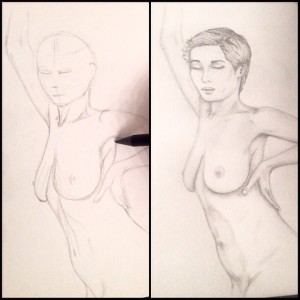 Around 85% of my followers in social media and about 95% of the participants of the sculpting and painting parties are females. From people who acquired my art so far is a very similar statistic. When he buys a piece of art from me is for her. You can see my gravitation towards the female figure in my art and I think that is a connection most women perceive, but it is not only with my art. Back in college it was me and a lot of girls in almost every class. They could talk about anything shamelessly and even involve me in the conversations. That still happens today. Teaching or taking a class I am generally the only male. Recently, my wife took me to a gathering that looked like a girls’ night out. Allegedly, other guys were invited but I was the only one there.
Around 85% of my followers in social media and about 95% of the participants of the sculpting and painting parties are females. From people who acquired my art so far is a very similar statistic. When he buys a piece of art from me is for her. You can see my gravitation towards the female figure in my art and I think that is a connection most women perceive, but it is not only with my art. Back in college it was me and a lot of girls in almost every class. They could talk about anything shamelessly and even involve me in the conversations. That still happens today. Teaching or taking a class I am generally the only male. Recently, my wife took me to a gathering that looked like a girls’ night out. Allegedly, other guys were invited but I was the only one there.
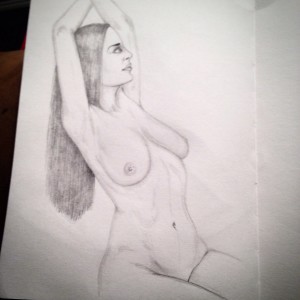 I was a manager on a OB-GYN office therefore no female conversation is scary to me. Nevertheless, I keep trying to convince myself that it is not weird at all and that I am used to it. Honestly, it feels like some kind of calling I can’t still fathom. We all, not only women, need to understand that we are all different for a reason, that nature and natural is a beautiful thing. If you are 40 and you don’t feel or look 20, there is a very simple explanation for that: You are not 20. We age, we change, and gravity affects us all. A ‘perfect body’ is ephemeral fantasy and trying to ‘fix it’ doesn’t make It more beautiful. Moreover, no matter how much we try to fix it we will never be satisfied, because the problem is not on the outside but in the inside.
I was a manager on a OB-GYN office therefore no female conversation is scary to me. Nevertheless, I keep trying to convince myself that it is not weird at all and that I am used to it. Honestly, it feels like some kind of calling I can’t still fathom. We all, not only women, need to understand that we are all different for a reason, that nature and natural is a beautiful thing. If you are 40 and you don’t feel or look 20, there is a very simple explanation for that: You are not 20. We age, we change, and gravity affects us all. A ‘perfect body’ is ephemeral fantasy and trying to ‘fix it’ doesn’t make It more beautiful. Moreover, no matter how much we try to fix it we will never be satisfied, because the problem is not on the outside but in the inside.

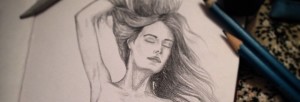
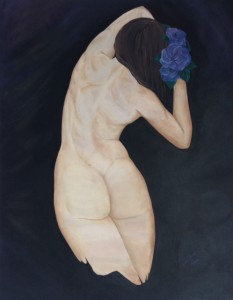

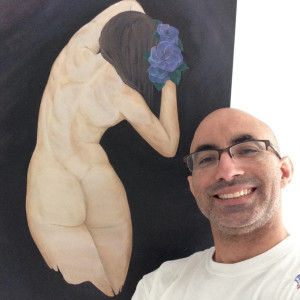 Detailing the muscles is very challenging but so much fun. I work one small area at a time and connect the muscles until the figure is complete. Hair comes after. To add a little something to the composition I added flowers this time. I was going in different directions with the flowers once I added the blue roses (which were originally purple) close to the head. First, and that was the original idea, I wanted to create a ‘u’ shaped frame of flowers and vines on the bottom half of the canvas. It was too much for me. The next idea was to just add a few flowers closing the figure at the bottom. I was not feeling it either, so I left it like that with just three blue roses. The rest is about cleaning up the details. After about 12 hours I was very satisfied with the result.
Detailing the muscles is very challenging but so much fun. I work one small area at a time and connect the muscles until the figure is complete. Hair comes after. To add a little something to the composition I added flowers this time. I was going in different directions with the flowers once I added the blue roses (which were originally purple) close to the head. First, and that was the original idea, I wanted to create a ‘u’ shaped frame of flowers and vines on the bottom half of the canvas. It was too much for me. The next idea was to just add a few flowers closing the figure at the bottom. I was not feeling it either, so I left it like that with just three blue roses. The rest is about cleaning up the details. After about 12 hours I was very satisfied with the result.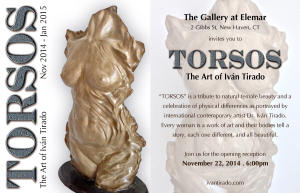
The Science in the Art
It has been a while since last time I wrote in my blog. It has been a great journey so far this semester teaching Inquiry at Quinnipiac University, the academic advising experiment, the sculpting and painting parties, the workshops and talks on Business Needs Assessment with an Inquiry Approach, the show that just ended at Spectrum Gallery, the sculpting demo I had there back in March, the sculpting workshop at Columbus School through ARTE Inc., the computer classes at the now Literacy Volunteers of Southern Connecticut, and a new partnership unfolding that gets me closer to understand my mission and the reason I do what I do… Well, that was a long sentence… Things are wrapping up as we are about a month away to finish the semester. The summer (if we get one this year in New England) is already promising good things. I think that brings us up-to-date in everything that is happening.
The Science in the Art
My students were working in groups to get feedback from each other as they prepared for their oral presentations. This is one way research in peer tutoring learning environments supports practice and practice supports research. In the process, one student was trying to find a connection between health sciences, specifically medicine, and art. To serve as an example that helped make the connection clear and concrete we have the Frank H. Netter M.D. School of Medicine at Quinnipiac University. Frank H. Netter M.D. was a surgeon and world’s most prolific medical illustrator. He helped medicine understand the human body with his illustrations. Interestingly, when people study medicine they call it medical arts. Not finding the connection yet? Let me help you understand. All the knowledge in science, or in any field, is incomplete without the capacity to think creatively to solve specific issues or to accurately come up with a diagnosis.